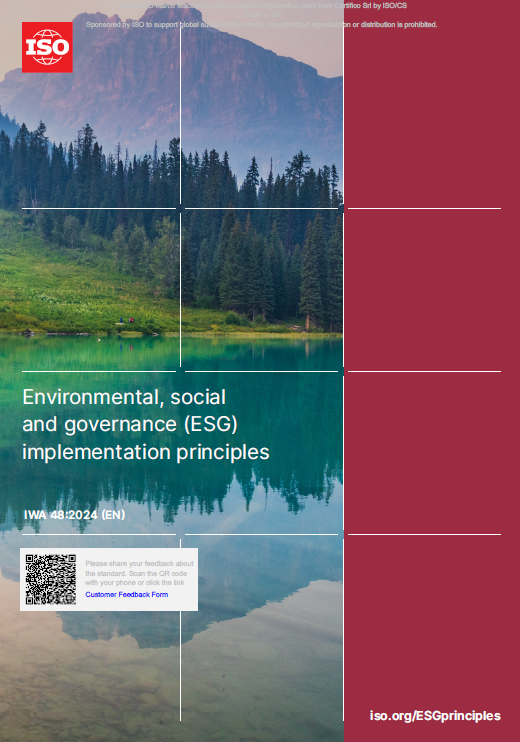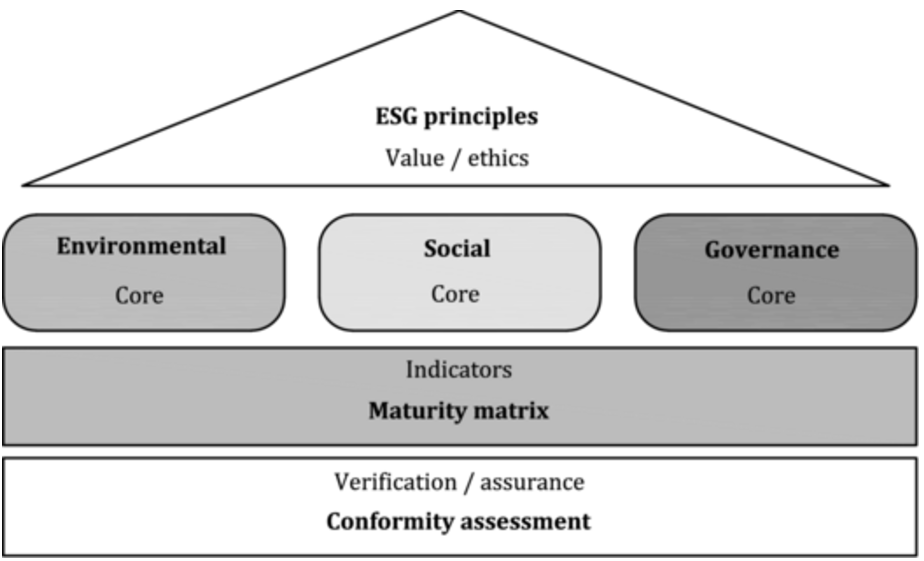IWA 48:2024 / Framework for implementing environmental, social and governance (ESG) principles - ISO 11.2024
| News | ||
| Newsletter n. 99146 del 13 Giugno 2025 | ||
| Salve Visitatore | ||
|
IWA 48 / Framework implementing ESG principles - ISO 11.2024 ID 23020 | 27.11.2024 / Full attached - International Workshop Agreement (IWA) 48:2024 This document provides a high-level framework and set of principles to give guidance on how to implement and embed environmental, social and governance (ESG) within the culture of an organization to support management of ESG performance, measurement and reporting, enabling consistency, comparability and reliability of ESG reporting and practices globally. This document provides guidance that identifies high-level principles and thinking that cover all elements of ESG, thus providing integrated solutions, with measurable key performance indicators (KPIs) to support the evaluation of maturity levels within the organization. This document is applicable to a wide range of organizations of all types and sizes across the globe including SMEs and organizations in low- and middle-income countries. It is complementary and interoperable with existing voluntary and regulatory reporting frameworks to facilitate global harmonization and alignment on ESG principles and approaches and is not in itself a reporting framework. Edition 1, 2024 ISO's ESG Implementation Principles (IWA 48) is a high-level structure and set of principles designed to guide organizations in implementing and embedding Environmental, Social, and Governance (ESG) practices within their organizational culture. This document supports the management of ESG performance and facilitates measurement and reporting under existing frameworks, enabling consistency, comparability, and reliability of ESG reporting and practices globally. These principles serve as a universal language for ESG practices, establishing an international reference model that ensures global interoperability and reliability in ESG reporting and practices. This standardized guidance is key to fostering a lasting culture of ESG within organizations and businesses worldwide. The ISO ESG Implementation Principles not only helps individual organizations improve their ESG performance but also accelerates the global adoption of sustainable business practices, contributing to a more resilient and responsible business ecosystem worldwide. ISO's ESG Implementation Principles are designed for use by organizations of all sizes and sectors worldwide. They are particularly beneficial for: - Small and Medium-sized Enterprises (SMEs) This guidance helps identify existing high-level requirements that cover all elements of 'E', 'S' and 'G' in a holistic way to provide integrated solutions, including requirements that specify measurable key performance indicators to support the assessment of maturity levels within the organisation. The document encompasses a holistic perspective on ESG, incorporating not only climate action and conformity, but also essential principles of social inclusion and sound governance. Foreword ISO (the International Organization for Standardization) is a worldwide federation of national standards bodies (ISO member bodies). The work of preparing International Standards is normally carried out through ISO technical committees. Each member body interested in a subject for which a technical committee has been established has the right to be represented on that committee. International organizations, governmental and non-governmental, in liaison with ISO, also take part in the work. ISO collaborates closely with the International Electrotechnical Commission (IEC) on all matters of electrotechnical standardization. The procedures used to develop this document and those intended for its further maintenance are described in the ISO/IEC Directives, Part 1. In particular, the different approval criteria needed for the different types of ISO documents should be noted. This document was drafted in accordance with the editorial rules of the ISO/IEC Directives, Part 2 (see www.iso.org/directives). ISO draws attention to the possibility that the implementation of this document may involve the use of (a) patent(s). ISO takes no position concerning the evidence, validity or applicability of any claimed patent rights in respect thereof. As of the date of publication of this document, ISO had not received notice of (a) patent(s) which may be required to implement this document. However, implementers are cautioned that this may not represent the latest information, which may be obtained from the patent database available at www.iso.org/patents. ISO shall not be held responsible for identifying any or all such patent rights. Any trade name used in this document is information given for the convenience of users and does not constitute an endorsement. For an explanation of the voluntary nature of standards, the meaning of ISO specific terms and expressions related to conformity assessment, as well as information about ISO’s adherence to the World Trade Organization (WTO) principles in the Technical Barriers to Trade (TBT), see www.iso.org/iso/foreword.html. International Workshop Agreement IWA 48 was approved at virtual workshops hosted jointly by the Brazilian Technical Standards Association (ABNT), the British Standards Institution (BSI) and the Standards Council of Canada (SCC), in July and October 2024. Any feedback or questions on this document should be directed to the user’s national standards body. A complete listing of these bodies can be found at www.iso.org/members.html. 0.1 What is ESG? ESG is distinctive for organizations partly because it focuses the attention of decision-makers on the impacts and accountability of organizations with respect to communities, the environment and everyday lives. Regulatory bodies, policy makers and investors are particularly interested in ESG for this precise reason, and because everyone has the potential to be an interested party in the outcomes of ESG activities. Being open, honest and factual about all aspects of the organization is a positive ESG trait which underpins good governance (the “G” of ESG) that takes full account of the direct and indirect, individual and collective end-outcomes of organizations’ activities, products and services and has regard for external influences, regardless of their source, type, size or jurisdiction, including their supply chains and customers. ESG involves accurate and regular reporting of financial and non-financial material impacts, but ESG is not just about reporting. The focus of this document is deliberately on the implementing and embedding of ESG practices and values throughout an organization’s culture and activities. EXAMPLE 1 ESG can include: ESG draws on and supports the UN SDGs to help define positive social and environmental outcomes. Furthermore, ESG can be considered as connected to and convergent with sustainable development. EXAMPLE 2 SDG 6 is to ensure the availability and sustainable management of water and sanitation for all. Access to safe water, sanitation and hygiene can be a material consideration for the organization and the communities it is engaged with. ISO 4600 can help organizations or communities who heavily rely on water activities with demonstrating their ESG credentials. This document is intended as a contribution for organizations considering the impacts of the 17 SDGs and how they can optimize the links between ESG activities in the context of selected SDGs. NOTE ISO in collaboration with UNDP have developed guidelines for contributing to the UN SDGs (ISO/UNDP PAS 53002)[3]. 0.2 ESG landscape The ESG landscape is currently complex. There are many overlapping and competing ESG standards and frameworks, some mandatory requirements, some voluntary and some commercial. Different methodologies and forms of measurement, varied definitions and competing approaches result in confusion and this has undermined the trust in ESG claims which, in turn, has tended to discourage investment and further engagement in ESG by organizations. 0.3 The evolving ESG landscape The overall ESG landscape is evolving and extending: Implementing the ESG framework can improve and accelerate organizational strategies and actions on sustainability by shaping policies and practices related to the environment, social values and conditions. The increased value resulting from adopting the ESG framework is demonstrated through ESG strategies, actions and how ESG reporting is conducted. Therefore, ESG strengthens both the organization and the community. 0.4 ESG framework The document offers incremental pathways for organizations with limited regulatory oversight or technical capacity, enabling all organizations to engage in ESG practices. An ESG strategy and implementation are intended to propel sustainability. Pursuing this document’s ESG principles can add significant value to an organization in terms of: The aim of this document is to assist as wide a group of interested parties as possible and to help organizations of all types and sizes to start, deepen or mature their ESG journey in a clear, accessible and straightforward manner. The ESG framework is intended to be complementary to and interoperable with existing voluntary and regulatory reporting frameworks to facilitate global harmonization and alignment on ESG principles and approaches. The ESG framework (see Figure 1) draws on relevant existing International Standards, without rewriting them, to bring together trusted materials in an overarching structure of principles and cross-cutting themes supported by key performance indicators (KPIs). This document responds directly to the identified needs of interested parties, including businesses, investors, communities, governments and consumers, who in turn need to respond to regulatory requirements. This document is outcome-focused and performance-based, enabling a holistic and measurable approach, facilitating sustainable change. The main components of this document are presented in Figure 1. Figure 1 Main components of the ESG framework Collegati
|
||
 |
||
|
è un sito di INVIO NEWSLETTTER Se vuoi cancellarti dall'invio della newsletter oppure effettua il login al sito ed entra nella Tua Area Riservata, in “Modifica dati” agisci con la spunta sul box di selezione “Newsletter”. L'Elenco completo di tutte le ns newsletter è qui: Archivio newsletter |
||
  |
||
| Certifico Srl 2000-2025 | VAT IT02442650541 | ||


































